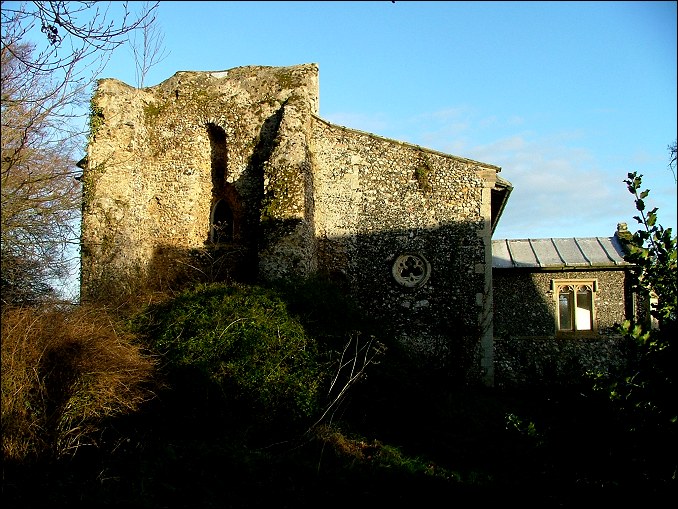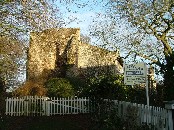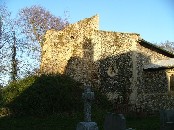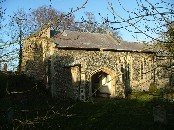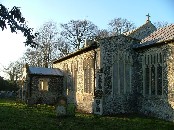| |
|
St
Nicholas, Woodrising It was getting late in the day.
We'd had the benefit of the first really lovely day of
the year, a bright and crisp combination of sunshine and
frost. But now the sun was low in the sky, sending long
shadows as if the gleaming tops of buildings were peeping
from a grey fog. And so we came to Woodrising.
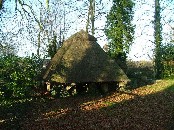 |
|
This
village has a beautiful name, and is set among
the woodlands and valleys south of the Letton
Hall estate.The road through is a fairly swift
one, and you might easily miss St Nicholas, not
least because the tower collapsed in the early
18th century. It has never been rebuilt, or even
tidied up, and is now a charming, overgrown ruin
at the west end of the church. Set back behind
cottages as it is, and surrounded by trees at a
bend in the road, you might not even recognise St
Nicholas as a church unless you looked more
closely. When the tower collapsed, the bell
frame was moved to a corner of the graveyard, and
covered with a thatched roof. It is still there
today, and currently contains one 19th century
bell.
|
I wondered
if the ruin of the tower, as charming as it is, might
give an indication of the inside of the church, but this
was not the case at all. St Nicholas inside is a delight.
The slanting light played across venerable oak and creamy
stone, picking out the brass of the candelabras. A play
of light and shadow on the south arcade and chancel arch
created a sense of unfolding spaces, of rooms opening off
each other, a chiaroscuro effect.
| The
chancel arch has two of the most characterful
corbel heads I've ever seen. That behind the
pulpit particularly; he is yawning wildly, which
may even be appropriate sometimes. The south
aisle extends eastwards beyond the chancel arch
for a bay, with a raised platform at its eastern
end and a table tomb separating aisle from
chancel. There is no name on the tomb, and the
brass inlay is now empty. It is old enough to be
contemporary with the Witchingham family when
they were Lords of the Manor here. Curiously,
there are two squints into the chancel, one at
each end of the tomb, suggesting that there was
an altar against the east wall, and another at
the west end of the tomb.
|
|
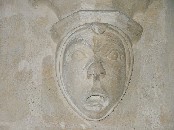 |
As
Mortlock observes, there is a most agreeable lack of
symmetry. The west end of the church is taken up by a
narrow gallery, and at the top is one of East Anglia's
six surviving church barrel organs. The benches are
understated 19th century attempts at late medieval. It is
a well-kept yet slightly ramshackle interior, a
collection of bits and pieces from every century that
give St Nicholas a character all of its own. I liked it a
lot. I couldn't think of another church quite like it,
and it has stuck in my memory since.
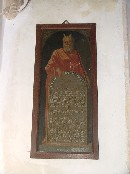 |
|
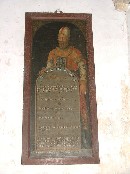 |
|
And
in the chancel there are more surprises. The
decalogue boards are tall portraits of Moses and
Aaron holding the tablets of stone. Both look
sombre in the austere sanctuary. On the
north side of the chancel, set in a cage of
columns in a place where there'd have been an
Easter Sepulchre a few years earlier, is the 1564
effigy of Sir Richard Southwell. He wasn't a very
nice person; 'unscrupulous' is the word Mortlock
chooses to describe a man who was vain,
treacherous and self-seeking. Adopted by the Duke
of Norfolk after the death of his father,
Southwell was brought up with the young Henry
Howard, Earl of Surrey, only to betray him to the
authorities in 1547. Surrey was executed for
treason, but Southwell went on to achieve power
and fame.
|
If the Southwells are remembered at all
today, however, it is only because of Sir Richard's
grandson Robert, who was a Saint - quite literally. While
at Cambridge University, Robert was received back into
the Catholic faith that his grandfather had renounced,
and went off to the continent to train for the
Priesthood. Returning to England a Jesuit Priest, he was
considered fair game for the authorities, despite his
noble birth. In 1594 he was captured, tortured and
interrogated.
On the 21st of February
1595, he was led out to die at Tyburn. Hung by
the neck until he began to lose consciousness, he
was cut down, and his genitals were removed and
his bowels wound out, both being consigned to the
fire in front of his eyes. His arms and legs were
hacked off, and at last he was beheaded. He was
just 34 years old.
By a great irony, Henry Howard's
grandson Philip also became a Catholic,
and was similarly sentenced to death, although
mercifully he died in prison before the sentence
could be carried out. In 1970, they were both
added to the Canon of Saints by Pope Paul VI as
two of the Blessed Martyrs of England and Wales.
|
|
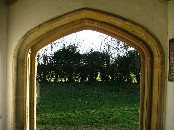 |
|
|
|

